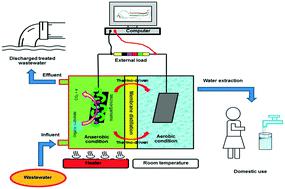当前位置:
X-MOL 学术
›
Environ. Sci.: Water Res. Technol.
›
论文详情
Our official English website, www.x-mol.net, welcomes your
feedback! (Note: you will need to create a separate account there.)
A promising bioelectrochemical reactor integrating membrane distillation and microbial fuel cell for dual advantages of power generation and water recovery
Environmental Science: Water Research & Technology ( IF 3.5 ) Pub Date : 2020-07-14 , DOI: 10.1039/d0ew00379d Thanh Ngoc-Dan Cao, Shiao-Shing Chen, Hau-Ming Chang, Thanh Xuan Bui, I-Chieh Chien
Environmental Science: Water Research & Technology ( IF 3.5 ) Pub Date : 2020-07-14 , DOI: 10.1039/d0ew00379d Thanh Ngoc-Dan Cao, Shiao-Shing Chen, Hau-Ming Chang, Thanh Xuan Bui, I-Chieh Chien

|
In the present study, water recovery from wastewater was accomplished simultaneously with the electrical energy production from biofuel as a source of organic matter, by the novel integration of distillation membrane and microbial fuel cell to create a system called the membrane distillation microbial fuel cell (MDMFC). A hydrophobic 0.45 μm membrane made of polytetrafluoroethylene (PTFE) was employed as a separator between the cathodic and anodic compartments to investigate multiple benefits of MDMFC for electricity generation, wastewater treatment and water reclamation at different temperature conditions. A high open-circuit voltage of 0.724 ± 0.07 V and a short circuit current of 64.55 ± 2.56 μA were achieved at 45 °C with an initial flux of 3.5 LMH. In the anodic chamber, Firmicutes, Proteobacteria, and Bacteroidetes were detected as dominant species at 45 °C, among which the Proteobacteria and Firmicutes were the most abundant sequences when an artificial substrate was used for feeding. The results indicate that 45 °C is the temperature that most significantly influences the electrochemical performance of MDMFC because of the dominance of bacterial community. Moreover, the power density increased by 99.9% when the temperature increased from 35 °C (0.99 μW m−3) to 45 °C (1552 μW m−3) and decreased by 97% when the temperature was further increased to 55 °C (43.91 μW m−3). Consequently, this study confirms that MD and MFC can be combined for the sustainable development of a water-energy nexus.
中文翻译:

集成膜蒸馏和微生物燃料电池的有前途的生物电化学反应器,具有发电和水回收的双重优势
在本研究中,通过将蒸馏膜和微生物燃料电池进行新型集成以创建一个称为膜蒸馏微生物燃料电池(MDMFC)的系统,同时完成了从废水中的水回收和从作为生物质来源的生物燃料生产电能的过程。 )。以聚四氟乙烯(PTFE)制成的疏水性0.45μm膜作为阴极和阳极隔室之间的隔离器,以研究MDMFC在不同温度条件下发电,废水处理和水回收的多重益处。在45°C下以3.5 LMH的初始通量实现了0.724±0.07 V的高开路电压和64.55±2.56μA的短路电流。在阳极室,Firmicutes,变形菌,和拟杆菌在45℃下,其中所述被检测为优势种变形菌门和厚壁菌门是当使用用于馈送人工基质中最丰富的序列。结果表明,由于细菌群落的优势,45°C是最显着影响MDMFC电化学性能的温度。此外,当温度从35°C(0.99μWm -3)增加到45°C(1552μWm -3)时,功率密度增加99.9%,而当温度进一步增加到55°C时,功率密度减少97%。 (43.91μW米-3)。因此,这项研究证实了MD和MFC可以结合用于水能关系的可持续发展。
更新日期:2020-07-14
中文翻译:

集成膜蒸馏和微生物燃料电池的有前途的生物电化学反应器,具有发电和水回收的双重优势
在本研究中,通过将蒸馏膜和微生物燃料电池进行新型集成以创建一个称为膜蒸馏微生物燃料电池(MDMFC)的系统,同时完成了从废水中的水回收和从作为生物质来源的生物燃料生产电能的过程。 )。以聚四氟乙烯(PTFE)制成的疏水性0.45μm膜作为阴极和阳极隔室之间的隔离器,以研究MDMFC在不同温度条件下发电,废水处理和水回收的多重益处。在45°C下以3.5 LMH的初始通量实现了0.724±0.07 V的高开路电压和64.55±2.56μA的短路电流。在阳极室,Firmicutes,变形菌,和拟杆菌在45℃下,其中所述被检测为优势种变形菌门和厚壁菌门是当使用用于馈送人工基质中最丰富的序列。结果表明,由于细菌群落的优势,45°C是最显着影响MDMFC电化学性能的温度。此外,当温度从35°C(0.99μWm -3)增加到45°C(1552μWm -3)时,功率密度增加99.9%,而当温度进一步增加到55°C时,功率密度减少97%。 (43.91μW米-3)。因此,这项研究证实了MD和MFC可以结合用于水能关系的可持续发展。











































 京公网安备 11010802027423号
京公网安备 11010802027423号